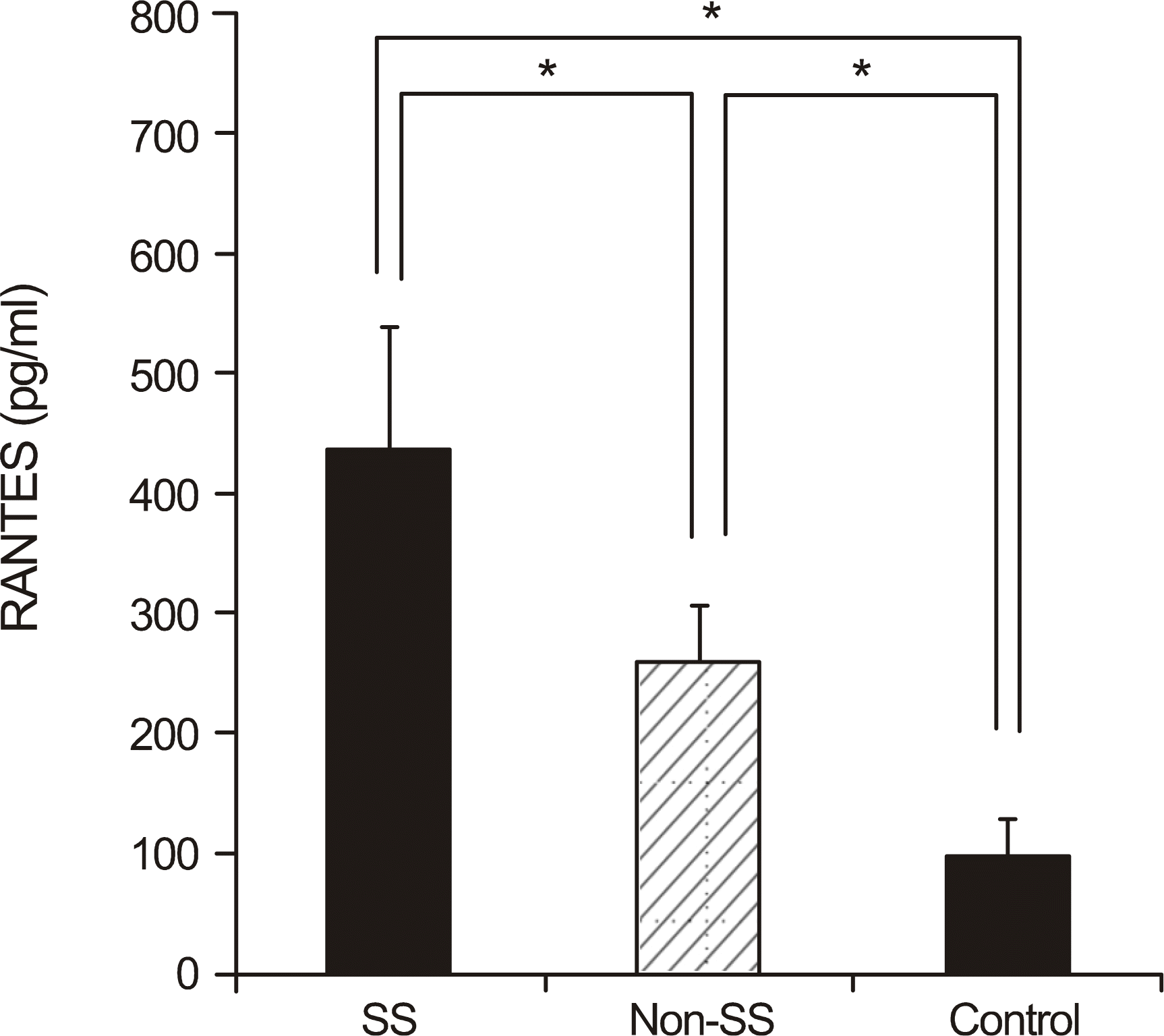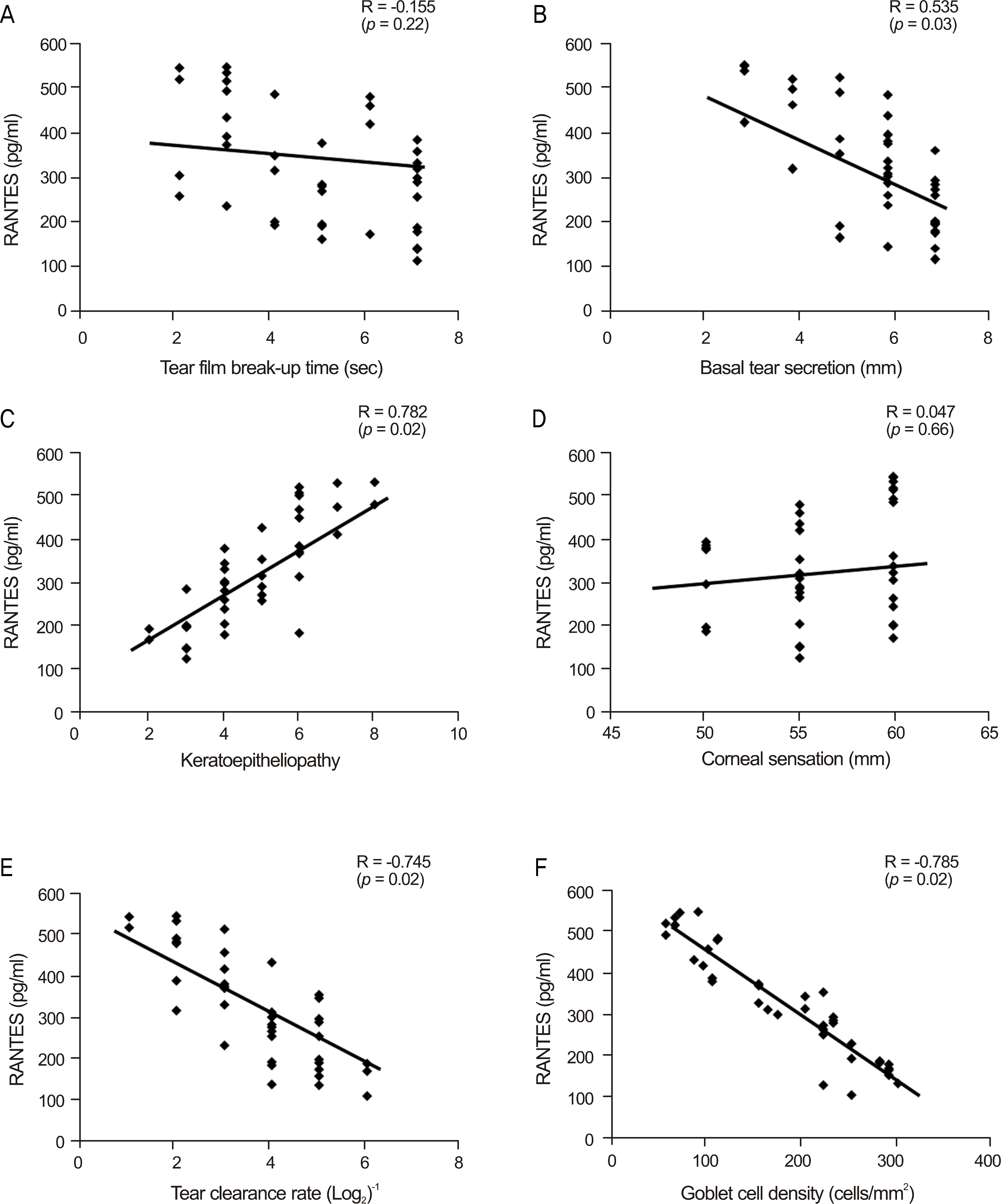Abstract
Purpose
To investigate the expression of CCL5/RANTES (regulated upon activation, normal T cell expressed and secreted) in the tears of dry eye patients.
Methods
Forty patients with dry eye (15 Sjögren's and 25 non-Sjögren's syndrome patients) and ten control subjects were recruited for the present study. The concentration of RANTES in tears was measured using an enzyme-linked immunosorbent assay. The correlations between RANTES level, tear film and ocular surface parameters, including tear film break-up time, basal tear secretion, tear clearance rate, corneal sensation, keratoepitheliopathy, and conjunctival goblet cell density, were analyzed in patients with dry eye syndrome.
Results
The concentrations of RANTES were 435.46 ± 104.45 pg/ml in Sjögren's syndrome patients, 257.42 ± 46.72 pg/ml in non-Sjögren's syndrome patients, and 97.53 ± 29.15 pg/ml in the control patients (p < 0.01). The levels correlated significantly with basal tear secretion, tear clearance rate, keratoepitheliopathy, and goblet cell density (p < 0.05).
References
1. The definition and classification of dry eye disease: report of the Definition and Classification Subcommittee of the International Dry Eye WorkShop (2007). Ocul Surf. 2007; 5:75–92.
2. Moss SE, Klein R, Klein BE. Prevalence of and risk factors for dry eye syndrome. Arch Ophthalmol. 2000; 118:1264–8.

3. Lee AJ, Lee J, Saw SM, et al. Prevalence and risk factors associated with dry eye symptoms: a population based study in Indonesia. Br J Ophthalmol. 2002; 86:1347–51.

4. Uchino M, Uchino Y, Dogru M, et al. Dry eye disease in Japan: An epidemiologic study. Cornea. 2009; 28:S31–4.

5. Stern ME, Gao J, Schwalb TA, et al. Conjunctival T-cell sub-populations in Sjögren's and non-Sjögren's patients with dry eye. Invest Ophthalmol Vis Sci. 2002; 43:2609–14.
6. Rolando M, Barabino S, Mingari C, et al. Distribution of conjunctival HLA-DR expression and the pathogenesis of damage in early dry eyes. Cornea. 2005; 24:951–4.

7. Pflugfelder SC, Jones D, Ji Z, et al. Altered cytokine balance in the tear fluid and conjunctiva of patients with Sjögren's syndrome keratoconjunctivitis sicca. Curr Eye Res. 1999; 19:201–11.

8. Yoon KC, Jeong IY, Park YG, Yang SY. Interleukin-6 and tumor necrosis factor-alpha levels in tears of patients with dry eye syndrome. Cornea. 2007; 26:431–7.
9. Corrales RM, Stern ME, De Paiva CS, et al. Desiccating stress stimulates expression of matrix metalloproteinases by the corneal epithelium. Invest Ophthalmol Vis Sci. 2006; 47:3293–302.

10. Baudouin C, Liang H, Bremond-Gignac D, et al. CCR 4 and CCR 5 expression in conjunctival specimens as differential markers of T(H)1/ T(H)2 in ocular surface disorders. J Allergy Clin Immunol. 2005; 116:614–9.
11. Gulati A, Sacchetti M, Bonini S, Dana R. Chemokine receptor CCR5 expression in conjunctival epithelium of patients with dry eye syndrome. Arch Ophthalmol. 2006; 124:710–6.

12. Yoon KC, De Paiva CS, Qi H, et al. Expression of Th-1 chemo-kines and chemokine receptors on the ocular surface of C57BL/6 mice: effects of desiccating stress. Invest Ophthalmol Vis Sci. 2007; 48:2561–9.

13. Yoon KC, De Paiva CS, Qi H, et al. Desiccating environmental stress exacerbates autoimmune lacrimal keratoconjunctivitis in non-obese diabetic mice. J Autoimmun. 2008; 30:212–21.

14. Yoon KC, Park CS, You IC, et al. Expression of CXCL9, −10, −11, and CXCR3 in the tear film and ocular surface of patients with dry eye syndrome. Invest Ophthalmol Vis Sci. 2010; 51:643–50.

15. Kim HG, You IC, Yoon KC. I-TAC concentration in tears of dry eye patients and its correlation with tear surface parameters. J Korean Ophthalmol Soc. 2008; 49:1565–71.

16. Vitali C, Bombardieri S, Jonsson R, et al. Classification criteria for Sjögren's syndrome: a revised version of the European criteria pro-posed by the American-European Consensus Group. Ann Rheum Dis. 2002; 61:554–8.
17. Dogru M, Katakami C, Inoue M. Tear function and ocular surface changes in noninsulin-dependent diabetes mellitus. Ophthalmology. 2001; 108:586–92.

18. Yoon KC, Jeong IY, Park YG, Yang SY. Interleukin-6 and tumor necrosis factor-alpha levels in tears of patients with dry eye syndrome. Cornea. 2007; 26:431–7.
20. Jones DT, Monroy D, Ji Z, et al. Sjögren's syndrome: cytokine and Epstein-Barr viral gene expression within the conjunctival epithelium. Invest Ophthalmol Vis Sci. 1994; 35:3493–504.
21. Lee SH, Im SK, Yoon KC. CCL4 concentration in tears of dry eye patients and its correlation with tear surface parameters. J Korean Ophthalmol Soc. 2010; 51:313–9.

22. Malesiń ski R, Bakunowicz-Ł azarczyk A, Wysocka J. The role of chemokines CCL3/ MIP-1 alfa and CCL4/ MIP-1 beta in pathogenesis of dry eye syndrome. Klin Oczna. 2008; 110:277–9.
23. Ogawa N, Kawanami T, Shimoyama K, et al. Expression of interferon-inducible T cell alpha chemoattractant (CXCL11) in the sali-vary glands of patients with Sjögren's syndrome. Clin Immunol. 2004; 112:235–8.
24. Petkovic V, Moghini C, Paoletti S, et al. I-TAC/CXCL11 is a natu-ral antagonist for CCR5. J Leukoc Biol. 2004; 76:701–8.

25. Donlon TA, Krensky AM, Wallace MR, et al. Localization of a human T-cell-specific gene, RANTES (D17S136E), to chromosome 17q11.2-q12. Genomics. 1990; 6:548–53.

26. Maghazachi AA, Al-Aoukaty A, Schall TJ. CC chemokines induce the generation of killer cells from CD56+ cells. Eur J Immunol. 1996; 26:315–9.

27. Song A, Nikolcheva T, Krensky AM. Transcriptional regulation of RANTES expression in T lymphocytes. Immunol Rev. 2000; 177:236–45.
28. Cocchi F, DeVico AL, Garzino-Demo A, et al. Identification of RANTES, MIP-1 alpha, and MIP-1 beta as the major HIV-sup-pressive factors produced by CD8+ T cells. Science. 1995; 270:1811–5.
29. Vangelista L, Secchi M, Liu X, et al. Engineering of Lactobacillus jensenii to secrete RANTES and a CCR5 antagonist analogue as live HIV-1 blockers. Antimicrob Agents Chemother. 2010; 54:2994–3001.
30. Bacon KB, Premack BA, Gardner P, Schall TJ. Activation of dual T cell signaling pathways by the chemokine RANTES. Science. 1995; 269:1727–30.

31. Appay V, Dunbar PR, Cerundolo V, et al. RANTES activates anti-gen-specific cytotoxic T lymphocytes in a mitogen-like manner through cell surface aggregation. Int Immunol. 2000; 12:1173–82.

32. Turner L, Ward SG, Westwick J. RANTES-activated human T lymphocytes. A role for phosphoinositide 3-kinase. J Immunol. 1995; 155:2437–44.
Figure 1.
RANTES levels in tears of Sjögren's syndrome patients, non-Sjögren's syndrome patients and control subjects. SS = Sjögren's syndrome. * p < 0.05.

Figure 2.
Correlation between RANTES levels in tears of dry eye patients and tear surface parameters including tear film break-up time (A), basal tear secretion (B), keratoepitheliopathy score (C), corneal sensation (D), tear clearance rate (E), and conjunctival goblet cell density (F).

Table 1.
Comparison of tear film parameters in dry eye patients with and without Sjögren's syndrome and control subjects
| Parameters | Control group (n = 10) |
Dry eye group |
||
|---|---|---|---|---|
| Non-SS (n = 25) | SS (n = 15) | Total (n = 40) | ||
| Tear film break-up time (mean ± SD, sec) | 13.43 ± 3.51 | 4.77 ± 1.85* | 3.83 ± 1.41*,† | 4.55 ± 1.75* |
| Basal tear secretion (mean ± SD, mm) | 13.41 ± 3.69 | 5.24 ± 2.31* | 3.80 ± 0.95*,† | 4.61 ± 1.74* |
| Tear clearance rate (mean ± SD, (Log2)−1) | 5.51 ± 1.25 | 2.85 ± 0.93* | 2.39 ± 0.87* | 2.64 ± 0.91* |
| Corneal sensation (mean ± SD, mm) | 58.95 ± 2.03 | 56.93 ± 3.31 | 54.85 ± 3.55* | 55.63 ± 3.41 |
| Keratoepitheliopathy score (mean ± SD) | 0.13 ± 0.22 | 2.41 ± 2.32* | 4.96 ± 2.95*,† | 3.58 ± 2.51* |
| Goblet cell density (mean ± SD, cell/mm2) | 337.3 ± 36.4 | 252.4 ± 46.6* | 152.9 ± 46.5*,† | 214.2 ± 46.5* |




 PDF
PDF ePub
ePub Citation
Citation Print
Print


 XML Download
XML Download